How To Upload Gps Data To Arcgis
2.1 Import GPS Data
Important! Before yous brainstorm this section, read the Chapter 2 Introduction and reply Teachback 1 on that page.
One of the easiest and most common means to create new geospatial information is using a mobile unit of measurement. GPS stands for , and is a operated by the United states authorities that provides real-fourth dimension position and time information anywhere on Earth. A GPS receiver captures orbital position and time information transmitted by four or more than orbiting GPS satellites and uses this data to calculate its ain geographic position in latitude, longitude, and altitude coordinates. For more data on how GPS works, visit the GPS.gov website.
GPS receivers tin can record their position for after reference in three ways: equally waypoints, routes, and tracks (Effigy 2.one). are point locations divers by a set of latitude, longitude, and altitude coordinates, along with a name and description given past the user. are pre-defined paths created from waypoints or points of involvement located from map software on the GPS receiver. are sequences of points called trackpoints, which are recorded automatically past the GPS receiver at regular intervals of time or distance. For case, a GPS receiver might be programmed to record a trackpoint every 50 feet. Tracks are thus like to breadcrumb trails, and can be transformed into vector line features by GIS software.
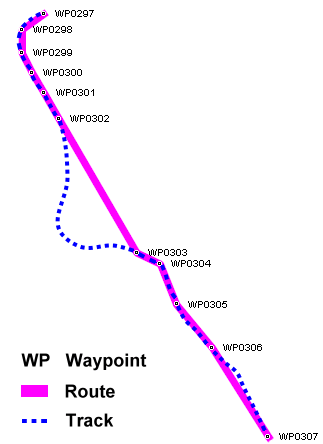
In this section, y'all will:
- Import GPS waypoints into an ArcGIS Pro project,
- Import GPS tracks into an ArcGIS Pro projection, and
- Convert imported trackpoints to lines.
 Import GPS waypoints into an ArcGIS Pro projection
Import GPS waypoints into an ArcGIS Pro projection
GPS data is stored in format, a human-readable format that can exist opened and viewed in a text editor. In society to be used in a GIS project, information collected with a GPS receiver unit must first exist converted to a native GIS format, such equally a or geodatabase . In ArcGIS Pro, this tin be done using a tool called GPX to Features.
If you are using waypoints and tracks that y'all collected with a GPS receiver unit of measurement yourself, re-create the data from the receiver unit of measurement to a GIS data folder on your calculator before proceeding. Refer to your GPS unit'southward documentation for instructions on copying the information to your computer. If y'all downloaded or were given GPX files from somewhere else, identify them in your GIS data folder before proceeding.
![]() Action Sequence
Action Sequence
1. Open up ArcGIS Pro and create a new map projection. Run into Section 1.1 if you need a refresher on how to do this.
ii. In the Itemize pane, add a new folder connection to your GIS data folder. Meet Department 1.3 if you demand to review how.
3. In the Analysis ribbon tab, click the "Tools" push to open up the Geoprocessing pane.
In ArcGIS Pro, the Geoprocessing pane gives you access to many tools that manipulate and clarify geospatial data. You volition brand use of this pane a great deal in the coming chapters.
4. In the search bar at the top of the Geoprocessing pane, type "GPX" (Figure two.2).
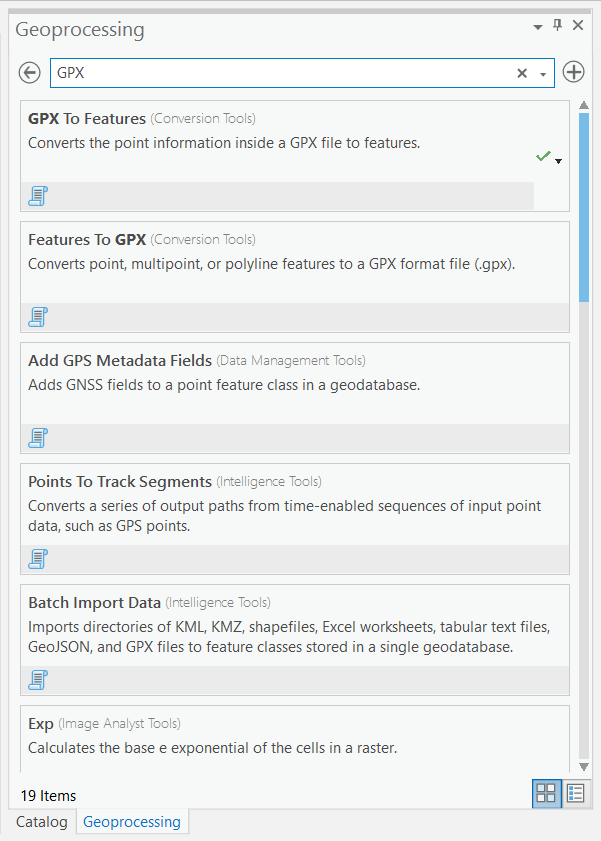
5. Click on the box of the commencement outcome, "GPX to Features", to open the GPX to Features tool.
6. On the right side of the "Input GPX File" field, click the Browse push button (which looks like a binder icon).
vii. In the Input GPX File window, on the left side, under "Projection", click "Folders".
8. Navigate to the .gpx file in your GIS information folder that contains the GPS waypoints, then select the file and click OK (Figure 2.iii).
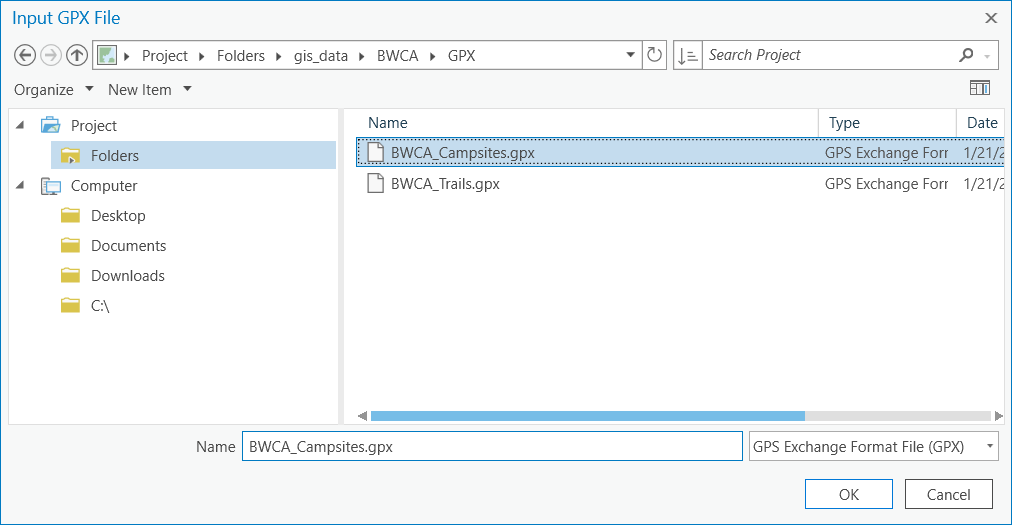
9. In the Geoprocessing pane, on the right side of the "Output Characteristic form" field, click the Browse button.
x. In the Output Feature class window, on the left side, under "Project", click "Databases" (Figure 2.four).
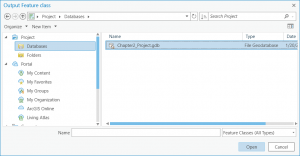
Every ArcGIS Pro project includes a created specifically for that project. The geodatabase is a user-friendly container for datasets that will be used in the project. Vector datasets inside a geodatabase are called . Using a geoprocessing tool to transfer information to the projection geodatabase preserves the original dataset in the GIS data binder for futurity use in other projects.
11. In the right side of the window, double-click the projection geodatabase; or click on it one time, then click "Open up".
12. In the "Name" field, requite your output feature class a suitable proper name with no spaces (y'all can apply an underscore character, "_", in place of spaces), then click the "Save" button.
thirteen. At the lesser of the Geoprocessing pane, click the "Run" button.
![]() Perception and Interpretation: The procedure runs, with a progress bar appearing at the bottom of the Geoprocessing pane. Once complete, point features corresponding to the locations of the stored GPS waypoints should announced on the map, and a new signal layer should appear in the Contents pane (Effigy 2.5).
Perception and Interpretation: The procedure runs, with a progress bar appearing at the bottom of the Geoprocessing pane. Once complete, point features corresponding to the locations of the stored GPS waypoints should announced on the map, and a new signal layer should appear in the Contents pane (Effigy 2.5).
14. If a Catalog tab is visible at the bottom of the right pane, click it. If not, click the View ribbon tab, and then click the "Catalog View" button.
fifteen. In the Itemize pane, expand the "Databases" item, then expand the projection database.
![]() Perception and Interpretation: A new bespeak feature form with the GPS waypoint data is contained past the project geodatabase (Figure two.5).
Perception and Interpretation: A new bespeak feature form with the GPS waypoint data is contained past the project geodatabase (Figure two.5).
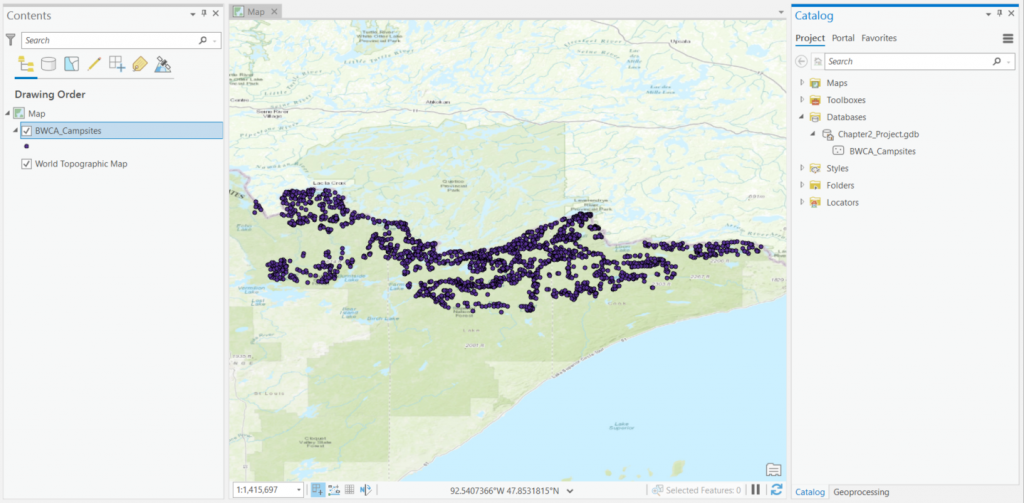
 Import GPS tracks into the ArcGIS Pro projection
Import GPS tracks into the ArcGIS Pro projection
![]() Activeness Sequence
Activeness Sequence
16. Return to viewing the Geoprocessing pane by clicking the Geoprocessing tab at the lesser of the right pane; or in the Analysis ribbon tab, click the "Tools" button.
17. If necessary, reopen the GPX to Features tool.
xviii. Repeat the procedure you lot followed previously to import the GPX file with tracks as a new characteristic class in the project geodatabase.
![]() Perception and Interpretation: The tracks may have longer to process than the waypoints because the file likely contains more data. When the processing is finished, a new point layer with the trackpoints from the GPX file should appear in the Contents pane, on the map, and as a feature grade in the projection geodatabase.
Perception and Interpretation: The tracks may have longer to process than the waypoints because the file likely contains more data. When the processing is finished, a new point layer with the trackpoints from the GPX file should appear in the Contents pane, on the map, and as a feature grade in the projection geodatabase.
- With the Explore tool active (in the Map ribbon tab), click on one of the imported waypoint features on the map to bring upwards its pop-upward. What information does it comprise?
- Click on one of the imported trackpoint features on the map to bring up its popup (which may also list surrounding trackpoints). What attribute information does it incorporate?
- What is different about trackpoints versus waypoints?
 Convert imported trackpoints to lines
Convert imported trackpoints to lines
As yous can see from the previous output, the GPX to Features tool just converts GPS tracks into trackpoints, without connecting the points as vertices in line segments. To create lines out of tracks, you demand to utilize a separate ArcGIS tool, the Points To Line tool.
![]() Activity Sequence
Activity Sequence
19. In the Geoprocessing pane, at the top, click the back button to return to the tool search bar; or, in the Assay ribbon tab, click the "Tools" button again.
20. In the Geoprocessing pane search bar, search for "Points To Line", then open up the Points To Line tool.
21. In the Geoprocessing pane, hover your cursor over the bluish question marking icon in the upper-right corner of the tool interface, then hover over each blue "i" icon that appears to the left of each input field when you move your mouse over the field.
![]() Perception and Interpretation: When you hover the cursor over the blue question mark icon, a large tooltip appears with a written and graphic caption of the tool'southward purpose (Figure ii.six, top). Clicking on the question mark icon will open the ArcGIS Pro Help folio for the tool in your browser. When y'all hover the cursor over each input field'due south "i" icon, a tooltip appears with information about what type of input should go in the field (Figure 2.vi, bottom).
Perception and Interpretation: When you hover the cursor over the blue question mark icon, a large tooltip appears with a written and graphic caption of the tool'southward purpose (Figure ii.six, top). Clicking on the question mark icon will open the ArcGIS Pro Help folio for the tool in your browser. When y'all hover the cursor over each input field'due south "i" icon, a tooltip appears with information about what type of input should go in the field (Figure 2.vi, bottom).
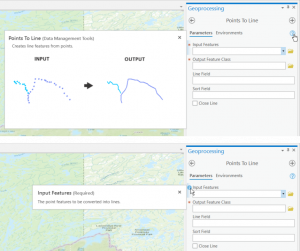
22. For "Input Features", choose the map layer containing the imported trackpoints.
23. Nether "Output Characteristic Class", browse to the project geodatabase and enter a suitable name for the line feature class.
24. Nether "Line Field", cull "Proper name".
25. If one of the options nether "Sort Field" is a time or appointment-time field, choose information technology; otherwise leave the input blank.
26. Exit "Shut Line" unchecked, and click the "Run" button.
![]() Perception and Estimation: The tool runs. Once complete, lines connecting the trackpoints should appear on the map, a new line layer should appear in the Contents pane, and the new line characteristic class should announced in the project geodatabase.
Perception and Estimation: The tool runs. Once complete, lines connecting the trackpoints should appear on the map, a new line layer should appear in the Contents pane, and the new line characteristic class should announced in the project geodatabase.
27. Save the project.
Did anything go wrong with converting the GPX data? If and then, what, why exercise you call up information technology happened, and how might you prepare the effect?
Additional information about the GPX To Features tool is available on the ArcGIS Pro Help website "GPX To Features (Conversion)" folio. Additional information about the Points To Line tool is bachelor on the ArcGIS Pro Assistance website "Points To Line (Information Management)" folio. You can access the ArcGIS Pro Help page for any geoprocessing tool past clicking the blue question marker icon in that appears in the upper-right corner of the tool's interface in the Geoprocessing pane.
Source: https://mlpp.pressbooks.pub/flexiblegisworkbookpro/chapter/2-1-import-gps-data/
Posted by: colemanpaland.blogspot.com

0 Response to "How To Upload Gps Data To Arcgis"
Post a Comment